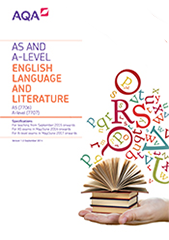3.3 Making connections
This part of the subject content focuses on language use in different types of text. It is called 'Making Connections' because it requires students to make active connections between a literary text and some non-literary material. The connections must be based either on a chosen theme or on the idea that particular linguistic strategies and features may occur in the different types of material. This area of the course provides an individualised experience for students, enabling them to demonstrate their ability to initiate and sustain independent enquiry.
Texts prescribed for study for the examined units may not be chosen, but further texts by the same authors or from a similar source are acceptable.
The nature of the non-literary material to be collected depends entirely on the focus of the task. A wide range of everyday texts and discourses in different genres and modes is possible. The non-literary material needs to qualify on the basis of forming a good source of data for students to use in their investigations.
Methods of language analysis
In working on this part of the subject content, students will learn about methods of language analysis. They will be required to adopt a close language focus, identifying salient features of language used in the respective texts.
The following list is a guide to the areas of language analysis students are expected to be familiar with:
- phonetics, phonology and prosodics
- lexis and semantics
- grammar, including morphology
- pragmatics
- discourse.
The application of these areas will depend on the specific topic chosen. For example, an investigation of how speech is represented may well focus in more detail on phonetics, phonology and prosodics, while an investigation of how storytelling works may focus in more detail on pragmatics and discourse.
Investigation
Some examples of possible types of exploration are given below. This list is not definitive.
- A comparison of openings in a novel and an autobiography.
- An exploration of real and fictional events.
- Representations of particular themes in literary and non-literary sources.
- What is a character? An exploration of the idea of character in literature and in other texts.
- How does storytelling work in different modes?
- An exploration of the use of non-literary genres within literary texts.
- An exploration of speech features in literature and in real-world communication.
- An exploration of new language in literature and non-literary contexts.
Students’ work will be assessed by the production of an investigation of 2,500-3,000 words in length. The investigation needs to contain the sections below. Word counts are given for guidance.
Introduction and aim(s) (750 words)
This initial section needs to demonstrate understanding of the texts selected for the study. The emphasis of this section should be on the literary text, but it should not simply offer a description of the text. Rather, it should give an account of the text which allows the reader to understand why the student has arrived at the aim(s) of the study and why they have made their selection(s) from the literary text. It will need to be clear that the student has read and understood the literary text as a whole in order to make their selection. This section should also justify and contextualise the non-literary material chosen for the study.
Review (300-500 words)
Students need to show that they have read some secondary sources and that they can offer a cogent discussion about the ideas they have encountered. These ideas may be about the material itself, about ideas for analysis, or a combination of the two. Citations and references must be accurately applied.
Analysis (1,250 words)
The analysis of the material is central to the study. This section should have some sub-headings which enable students to discuss the different aspects of language they have identified as salient in the previous section. They may choose to discuss the texts separately or together. How students present their analysis is up to them, but readability is important.
Conclusions (200-500 words)
This section needs to offer a summary of the main points revealed by the study. This should be in the form of an overview of what has been revealed by bringing the textual sources together, showing how the understanding of each text has been enhanced by consideration of the other.
